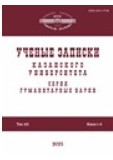ГИГИЕНА ОДЕЖДЫ КОЧЕВНИКОВ ВЕЛИКОЙ СТЕПИ XIII – XVI ВВ.
CLOTHING HYGIENE OF THE NOMADS OF THE GREAT STEPPE IN THE 13TH–16TH CENTURIES
Author(s): Lenar Firgatovich AbzalovSubject(s): Archaeology, Cultural history, Health and medicine and law, 13th to 14th Centuries, 15th Century, 16th Century
Published by: Казанский (Приволжский) федеральный университет
Keywords: nomads; Great Steppe; personal hygiene; clothing hygiene;
Summary/Abstract: This article considers the clothing hygiene of the nomads who lived in the Eurasian steppes during the 13th to 16th centuries. The analysis is based on the written sources from various epochs describing the life of the nomads in the Great Steppe, as well as on the data from archaeological surveys, ethnographic materials, and certain areas of medicine. The objective and subjective factors that determined the hygienic practices of the nomads in caring for their clothes are identified. The nomadic costume was designed to meet the needs of the nomadic life: it was practical and comfortable. Most garments were made of natural materials of animal origin and were therefore difficult to wash. For this and some other reasons, the nomads wore their clothes until they were completely worn out and cleaned them using drying, airing, shaking out, and freezing. The clothing hygiene of the noble nomads differed from that of the ordinary ones, mainly in how often they changed garments. Spiritual and ideological factors (prohibitions, superstitions, and omens) also played a certain role, but this needs to be explored in more detail. Since little is known about personal hygiene habits of the nomads, some of the conclusions made here may be controversial, which in turn will fuel further research on the traditional culture of life support among the nomads of the Eurasian steppes.
Journal: Ученые записки Казанского университета. Серия Гуманитарные науки
- Issue Year: 165/2023
- Issue No: 1-2
- Page Range: 70-84
- Page Count: 15
- Language: Russian

